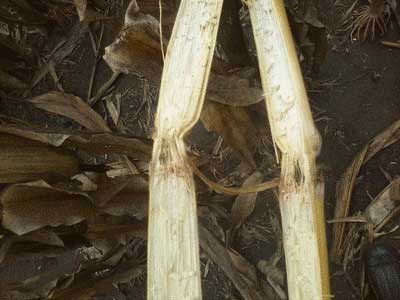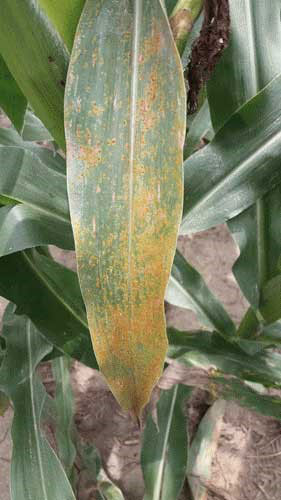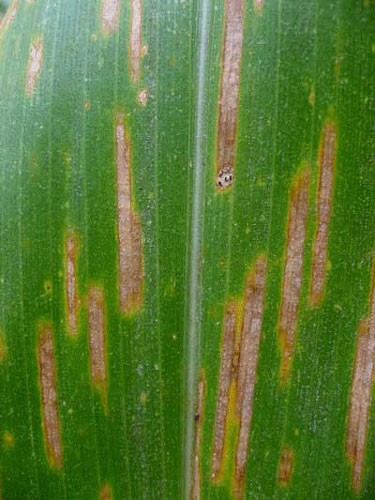Stalk lodging in corn occurs when the stalk weakens and breaks at some point below the ear (Figure 1). When this occurs, it results in harvest losses and slows down harvesting considerably. Grain moisture levels may also be unacceptably high in lodged corn.

Figure 1. Stalk rot in corn at Kansas River Valley Experiment Field, 2016. Photo by Eric Adee, K-State Research and Extension.
Two common causes of stalk lodging are stalk rot disease organisms or corn borer damage. Stalk rotting diseases in Kansas include charcoal rot, Fusarium, Gibberella, anthracnose, and Diplodia. Stalk rotting diseases are present in the soil or on old crop debris every year, but disease only develops when certain other factors predispose the plants to disease infection.
What are the most common causes of stalk lodging in corn throughout the state?
Carbohydrate depletion in the stalk during grain fill. High-yielding, “racehorse” hybrids tend to produce superior yields at the expense of late-season stalk integrity. These hybrids translocate a high percentage of carbohydrates from the stalks to the ears during grain fill. The latter is reflected with a substantial reduction in the stalk diameter from flowering until maturity (stem shrinking process). This weakens the lower stalk until eventually it will break over, possibly after becoming infected with a stalk rot disease. However, this does not mean producers should stay away from these hybrids. These hybrids have to be managed well. They should be harvested early, shortly after physiological maturity. This may mean harvesting the corn at about 20-25 percent grain moisture. Early harvest can result in discounts for high moisture, but it is better than leaving those hybrids in the field so long that stalks break.
Hybrid differences in stalk strength or stalk rot susceptibility. Some hybrids have genetically stronger stalks than others do. This is often related to a hybrid’s yield potential, as mentioned above, and how it allocates carbohydrates during grain fill. However, there are also genetic differences in stalk strength due to other reasons, including better resistance to stalk rot diseases. If a field of corn has stalk lodging problems, it could be due in part to hybrid selection.
Poor root growth and other stresses. Cold, waterlogged soils, severe drought, and soil compaction can all result in short, inadequate root systems and crowns that are damaged to the point that water and nutrients cannot effectively move through them. Under these conditions, the roots may not be able to extract enough water and nutrients from soil to support plant growth and carbohydrate production. When carbohydrate production is below-normal during any part of the growing season, the ears will continue to take what they need during grain fill, which can leave the stalks depleted even under average yield conditions. The developing ear always has priority for carbohydrates within the plant.
Poor leaf health. Any factor that results in poor leaf health will reduce carbohydrate production. When carbohydrate production from photosynthesis is inadequate due to loss of green leaf area in the leaves, the plant will mobilize reserves from the crown and lower stalk to complete grain fill (see carbohydrate depletion above).
Southern rust continues to arrive in Kansas earlier in the growing season, perhaps due to the overall warming trend in recent years (Figure 2). Late-planted corn is at a higher risk as it will be exposed to southern rust for a longer period of time than corn planted earlier in the spring. While there is direct yield loss due to less green tissue being available for photosynthesis, there are also secondary losses from increased levels of stalk rot.
Gray leaf spot is the other important foliar disease in Kansas that can affect stalk rot (Figure 3).

Figure 2. Southern leaf rust in corn. Photo by Doug Jardine, K-State Research and Extension.

Figure 3. Gray leaf spot on corn. Photo courtesy of Alison Robertson—© APS. Reproduced, by permission, from Wise, K., et al., eds. 2016. A Farmer's Guide to Corn Diseases. American Phytopathological Society, St. Paul, MN.
Many of the highest yielding hybrids lack good resistance to leaf diseases because the use of resistance genes can cause a “yield drag” in the hybrid. Therefore, when growing these hybrids, producers should be ready to apply a fungicide should leaf diseases develop. Bacterial leaf streak continues to spread in the state, however, its relationship to yield loss or increases in stalk rot are still unknown.
Stay green, another characteristic in hybrids, is highly correlated to stalk rot resistance and reduced lodging. The stay green effect associated with the use of strobilurin fungicides has also been reported to reduce lodging. This same characteristic may also interfere with grain dry-down in the field.
High plant density. Plants become tall and thin when supra-optimal populations are used, which result in thin stalks with inadequate strength. In addition, plant-to-plant competition for light, nutrients, and water enhances the competition for carbohydrates between the stalk and ear within the plant, thus reducing the vigor of the cells in the stalk and predisposing them to invasion by stalk rot.
Nutrient imbalances and/or deficiencies. Nutrient imbalances and/or deficiencies predispose corn plants to stalk rot and stalk lodging. Both potassium and chloride deficiency have been shown to reduce stalk quality and strength, and stalk rot resistance. High nitrogen levels coupled with low potassium levels increase the amount of premature stalk death and create an ideal situation for stalk rot and lodging. Soil chloride levels should be maintained above 20 lbs per acre.

Figure 4. High plant density corn presenting late-season stalk lodging. Photo by Ignacio Ciampitti, K-State Research and Extension.
Corn rootworm and corn borers. Damage caused by the corn rootworm and the European corn borer can predispose the corn plant to invasion by stalk rotting organisms, as well as lead to outright yield loss.
Mid-season hail damage. Similar to the damage caused by insects, the physical damage caused by mid-season hail can set up the plant for invasion by stalk rotting organisms. Stalk bruising and the resulting internal damage may also physically weaken corn stalks, making them more likely to lodge later in the season.
Rodrigo Borba Onofre, Postdoctoral Research & Extension Fellow
onofre@ksu.edu
Ignacio Ciampitti, Farming Systems
ciampitti@ksu.edu
Doug Jardine, Emeritus Plant Pathologist